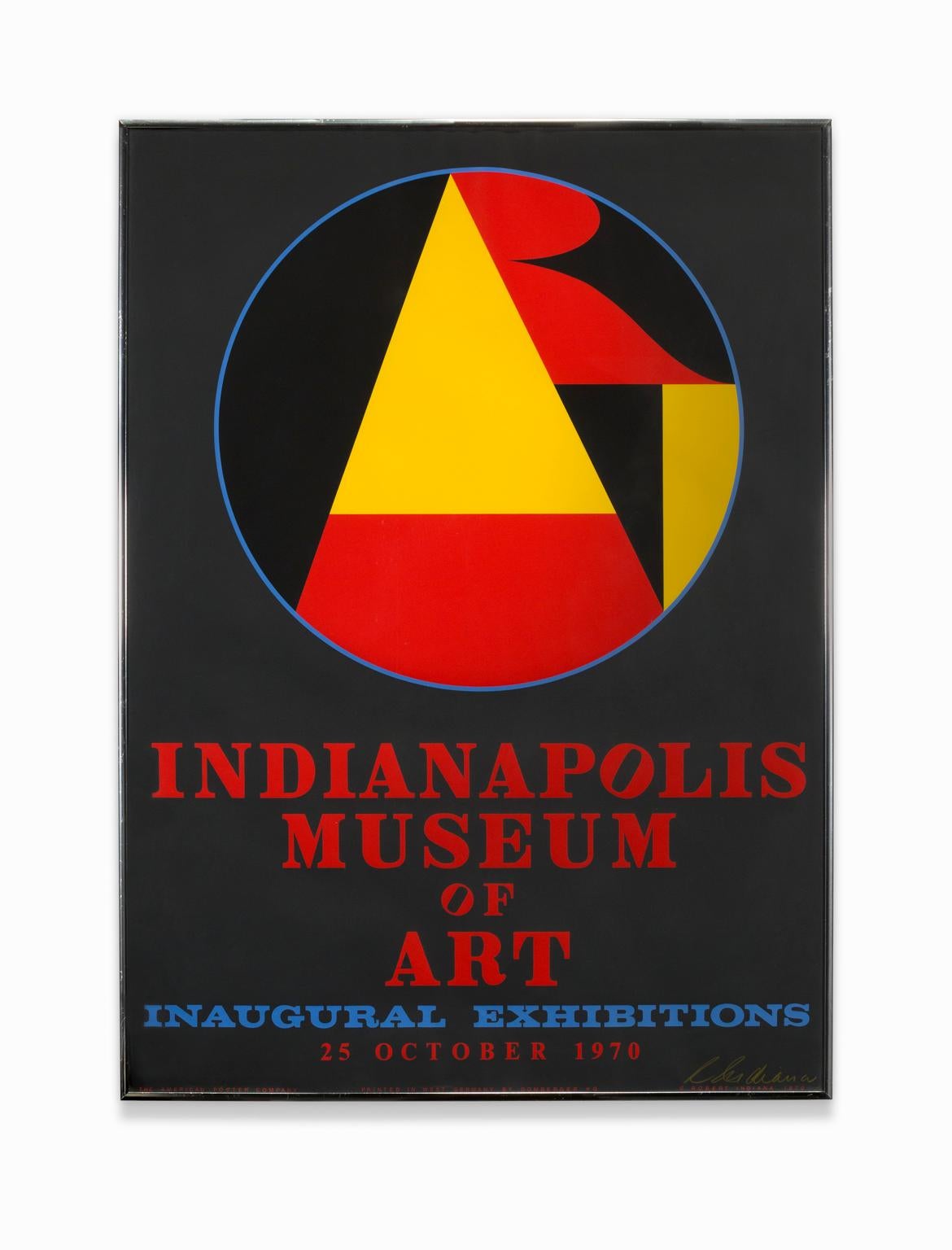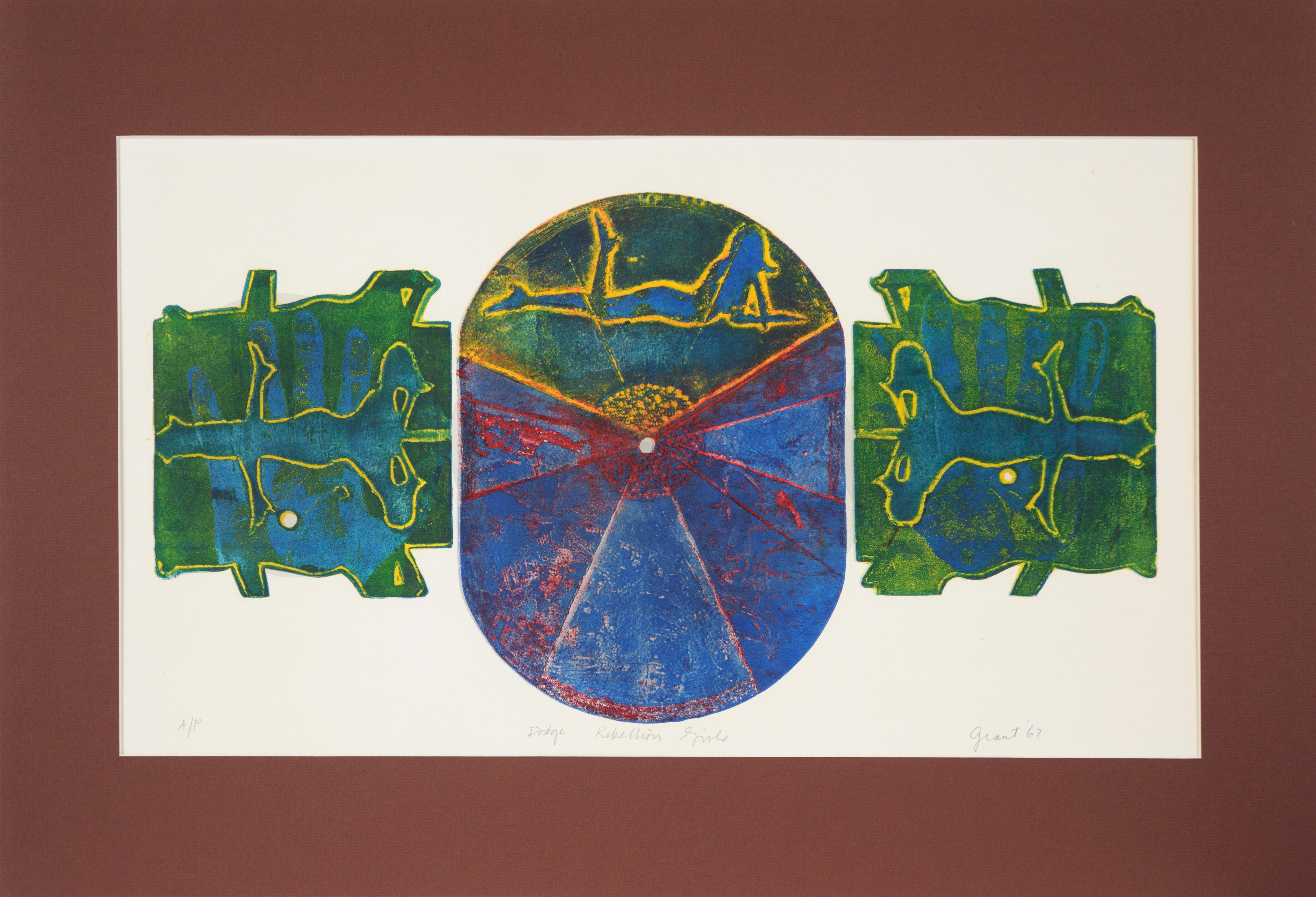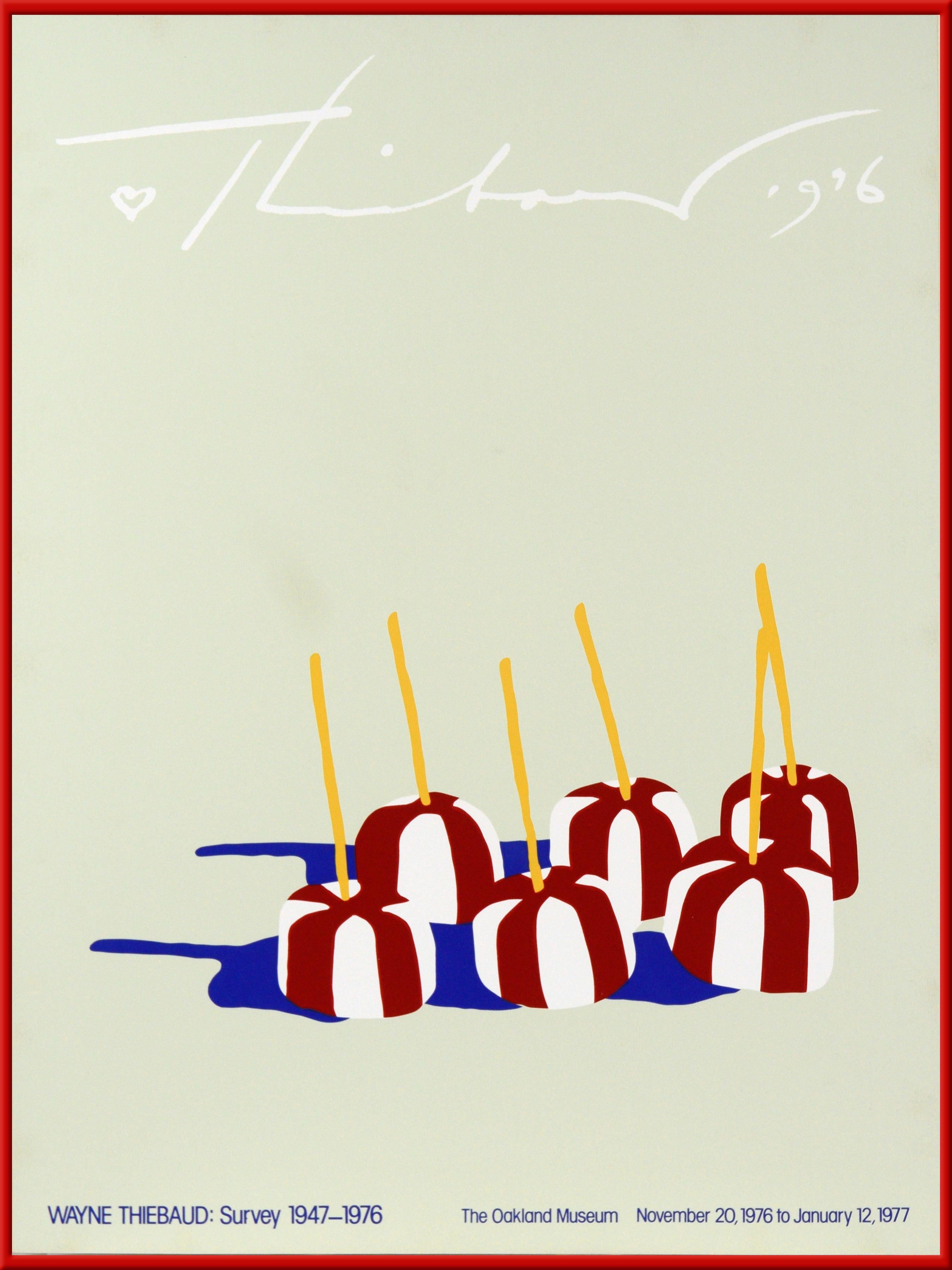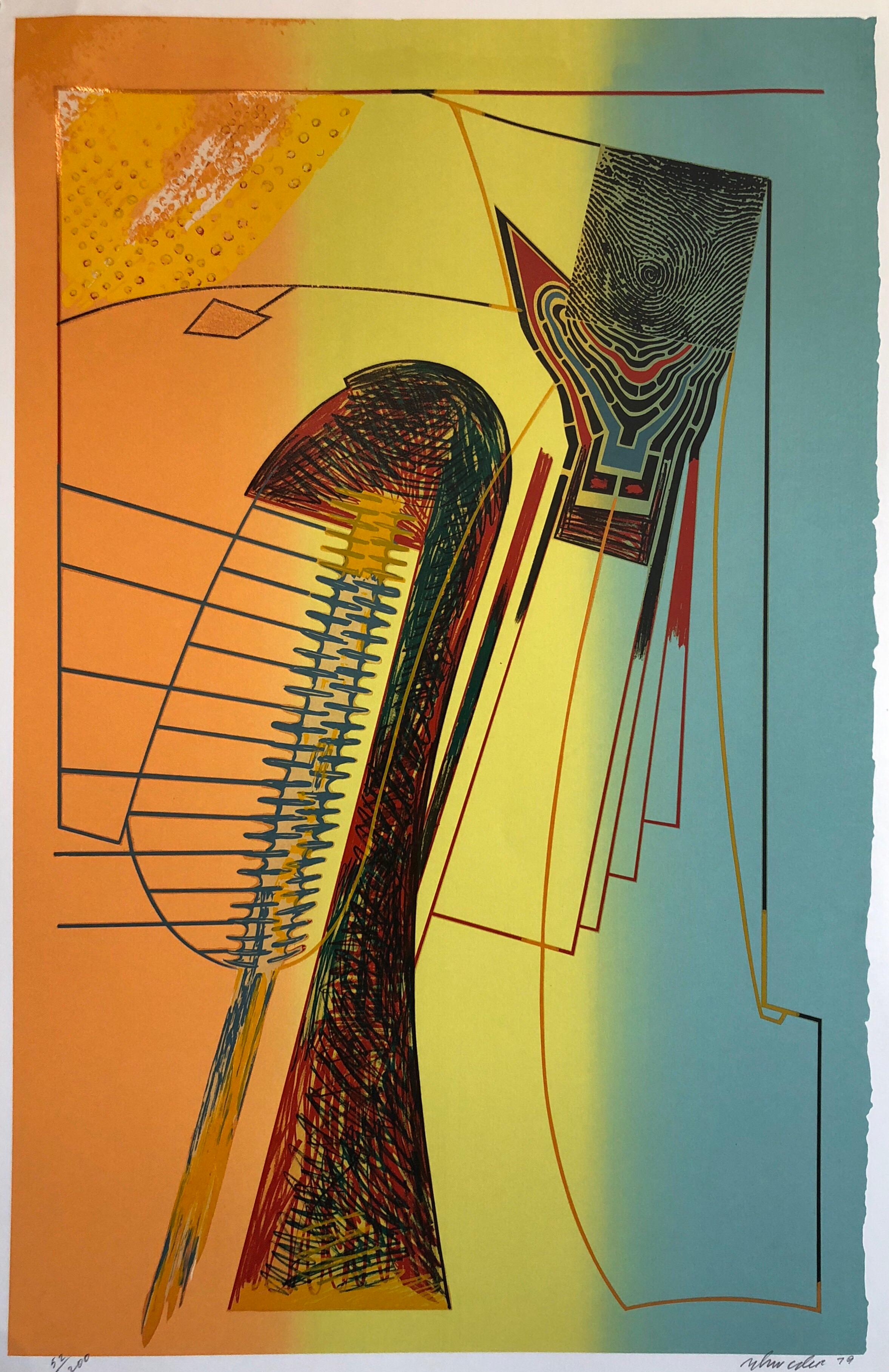Items Similar to Vintage Silkscreen Abstract -- The Wheely Whirly Steps
Want more images or videos?
Request additional images or videos from the seller
1 of 10
Alice AycockVintage Silkscreen Abstract -- The Wheely Whirly Steps1990
1990
About the Item
Expressive vintage silkscreen on black paper by Alice Aycock (American, 20th Century). Hand signed and dated "Alice Aycock 1990" with hand written description in conte crayon, "Above: The Wheely Whirly Steps; Below: Island of Assembly Place, edition: III/X,. " Image; 29"H x 22"W.
This piece is indicative of her early works which were site-specific structures, constructed of wood, stone, and earth, that drew heavily on childhood memories but were also rich with allusions to ancient history and architecture.
Biography from the National Gallery of Art: From childhood, Alice Aycock aspired to an artistic life. Inspired by stories told by her grandmother, which she later learned had their source in Gulliver's Travels, Aycock thought at first she would like to be a writer, but her interests shifted to the visual arts before she was twenty. Her sculptural-architectural sensibility was undoubtedly encouraged by her father, a construction engineer. As a child she watched him design and construct a scale model of a house he then built. Aycock's mother was especially supportive of her daughter's career; and one of the artist's first site pieces, Low Building with Dirt Roof (for Mary) (1973), was built with her mother's help on family property near New Kingston, Pennsylvania.
Aycock went to Douglass College in New Brunswick, New Jersey (B.A. 1968), then moved to New York and attended Hunter College (M.A. 1971), where Robert Morris was her teacher and adviser. She traveled intermittently, visiting sites in the American Southwest (Great Kivas), Greece and Turkey (Knossos, Epidaurus, Mycenaea), England and Mexico (Aztec temple at Malinaleo). Her Master's thesis, "An Incomplete Examination of the Highway Network/User/Perceiver Systems," was inspired in part by the underground passageways of the Mycenaean tholos tombs and the labyrinthine corridors of the ancient ruins at Knossos.
Aycock's early works were site-specific structures, constructed of wood, stone, and earth, that drew heavily on childhood memories but were also rich with allusions to ancient history and architecture. In the late 1970s her sources expanded to include literary references, often accompanied by cryptic, elusive texts. During the 1980s the work incorporated steel and other components evoking industry, which reflected her investigations into the power and poetry of the machine and the mystery of metaphysical forces.
In addition to her work at Graphicstudio, Aycock has also worked at Tandem Press at the University of Wisconsin-Madison. She has produced screenprints in Chicago with John W. Roberts, and at Ohio University. A sculpture edition, Celestial Alphabet (1983), was published by Multiples, Inc., New York. She has been visiting artist at various institutions, including the University of South Florida, Hunter College, Williams Colleges, Rhode Island School of Design, Princeton University, and the San Francisco Art Institute.
Aycock has created installations throughout the world, including Israel, Germany, The Netherlands, Italy, Switzerland, and Japan, and at numerous locations in the United States, including the Museum of Modern Art, New York (1977), the San Francisco Art Institute (1979), Museum of Contemporary Art, Chicago (1983), Sheldon Memorial Art Gallery, Lincoln, Nebraska (1985), State University of New York, Buffalo (1988), Altantic Arts Center, New Smyrna Beach, Florida (1989), and the Storm King Art Center, Mountainville, New York (1990). In 1983 a retrospective exhibition was organized by the Württembergischer Kunstverein and traveled in Germany, The Netherlands, and Switzerland. (Fine/Corlett 1991, 145)
- Creator:Alice Aycock (1946, American)
- Creation Year:1990
- Dimensions:Height: 34.5 in (87.63 cm)Width: 27 in (68.58 cm)Depth: 2 in (5.08 cm)
- Medium:
- Movement & Style:
- Period:
- Condition:
- Gallery Location:Soquel, CA
- Reference Number:
About the Seller
5.0
Platinum Seller
These expertly vetted sellers are 1stDibs' most experienced sellers and are rated highest by our customers.
Established in 1986
1stDibs seller since 2014
2,514 sales on 1stDibs
Typical response time: <1 hour
- ShippingRetrieving quote...Ships From: Soquel, CA
- Return PolicyA return for this item may be initiated within 14 days of delivery.
More From This SellerView All
- "Dodge Rebellion Girls" - 1967 Original Silkscreen on Paper Artists ProofBy Marc Foster GrantLocated in Soquel, CA"Dodge Rebellion Girls" - 1967 Silkscreen on Paper 1967 color silkscreen depicting the Dodge Rebellion Girls by Marc Foster Grant (American, b. 1947). A silhouette of the 'dodge gi...Category
1960s American Modern Figurative Prints
MaterialsPaper, Ink, Screen
- "Wayne Thiebaud: Survey 1947-1976" Oakland Museum Show PosterBy (After) Wayne ThiebaudLocated in Soquel, CA"Wayne Thiebaud: Survey 1947-1976" Show Poster from the Oakland Museum 1976-1977 Silkscreen poster from the Oakland Museum 1976-1977 show "Wayne Thiebaud: Survey 1947-1976" with a printing of an original drawing (Six Candied Apples...Category
1970s American Modern Abstract Prints
MaterialsPaper, Screen
- Geometric Woman's Portrait - Rare Signed Graphite Drawing on Paper 1962Located in Soquel, CAGeometric Woman's Portrait - Rare Signed Graphite Drawing on Paper 1962 Beautiful, soft original drawing by Eugene Hawkins (American, b. 1933). A realistic depiction of a short-haired woman, her large lips parted into a soft smile. She's surrounded in geometric shapes offering a wonderful juxtaposition to the natural curves of her face and hair. Signed in pencil, "Eugene Hawkins '62" Presented in a new black mat. Mat size: 20"H x 16"W Paper size: 18.5"H x 14.5"W Eugene Hawkins (American, b. 1933) is a BIPOC artist known for his detailed portraiture and printmaking. He is listed in Who Was Who in American Art, 1564-1975, and his work was exhibited in the Whitney Museum of American Art. He spent the majority of his life working and exhibiting in Southern California. His work frequently touches upon socio-political subjects, making strong statements about the world. The California African American Museum features Eugene Hawkins's work in the Permanent Collection. Exhibition: 2017 Paperworks: Selections from the Permanent Collection focuses on works on paper produced from 1950-2000 and includes figurative, impressionistic, and abstract styles. The exhibition showcases the radically diverse range of works on paper created by African American and other artists over the last two centuries, and includes drawings, prints, paintings, and collages by Edward Mitchell Bannister...Category
1960s American Modern Figurative Prints
MaterialsGraphite, Paper
- "Fifty Years Later" - Linocut Print on Paper 1/10Located in Soquel, CA"Fifty Years Later" - Linocut Print on Paper 1/10 A silhouetted image of a person's profile dropping their ballot into a voting box. The simple shapes, t...Category
21st Century and Contemporary American Modern Figurative Prints
MaterialsLinocut, Paper
- Portrait of Modern Man - Multilayer Woodblock in Ink on PaperLocated in Soquel, CAPortrait of Anger - Multilayer Woodblock in Ink on Paper Bold and saturated woodblock print of a screaming man by Michael Dow (American, 20th Century). The man is centered in this m...Category
1990s American Modern Figurative Prints
MaterialsPaper, Ink, Woodcut
- "Henry S. Miller" Lithograph in Ink on Paper, #3 of 8Located in Soquel, CA"Henry S. Miller" Lithograph in Ink on Paper, #3 of 8 Surrealist lithograph by Stephen Tracy White (American, 1947-2005). A figure in the lower right corner is partially enclosed by a red rectangle. Biomorphic shapes are flowing out of the rectangle, stretching across the composition. The shapes are rendered with intricate linework and soft green shading. Numbered, titled, signed, and dated along the bottom: 3/8 Henry S. Miller S. Tracy White 1969/April Tag on verso from Lee Nordness Galleries, New York Presented in a silver aluminum frame. Shipped without glass. Frame size: 26.5"H x 36.25"W Image size: 23.5"H x 34.25"W Stephen Tracy White (American, 1947-2005) was born in Bronwood, Georgia. They studied at the University of New Mexico, earning a Bachelor of Fine Arts in Art in 1969. They worked at the Tamarind Lithography Workshop, printing pieces by William Crutchfield...Category
1960s American Modern Portrait Prints
MaterialsPaper, Ink, Lithograph
You May Also Like
- "Indianapolis Museum of Art Inaugural Exhibitions", Color Silkscreen, SignedBy Robert IndianaLocated in Detroit, MI"Indianapolis Museum of Art Inaugural Exhibitions", 25 October 1970, is an eye popping large bold colorful geometric abstract silk screen. It is signed on the lower right. Robert Indiana, one of the preeminent figures in American art since the 1960s, played a central role in the development of assemblage art, hard-edge painting, Pop art, Neo-Dada, American Modernism and Modern Art. A self-proclaimed “American painter of signs,” Indiana created a highly original body of work that explores American identity, personal history, and the power of abstraction and language, establishing an important legacy that resonates in the work of many contemporary artists such as Andy Warhol, Keith Haring, Roy Lectenstein, David Hockney, Romero Britto, Richard Hamilton and Robert Rauschenberg who make the written word a central element of their oeuvre. Robert Indiana was born Robert Clark in New Castle, Indiana on September 13, 1928. Adopted as an infant, he spent his childhood moving frequently throughout his namesake state. At 14 he moved to Indianapolis in order to attend Arsenal Technical High School, known for its strong arts curriculum. After graduating he spent three years in the U.S. Air Force and then studied at the Art Institute of Chicago, the Skowhegan School of Sculpture and Painting in Maine, and the Edinburgh College of Art in Scotland. In 1956, two years after moving to New York, Indiana met Ellsworth Kelly, and upon his recommendation took up residence in Coenties Slip, where a community of artists that would come to include Kelly, Agnes Martin, James Rosenquist, and Jack Youngerman had studios. Indiana, like some of his fellow artists, scavenged the area’s abandoned warehouses for materials, creating sculptural assemblages from old wooden beams, rusted metal wheels, and other remnants of the shipping trade that had thrived in Coenties Slip. The discovery of 19th century brass stencils led to the incorporation of brightly colored numbers and short emotionally charged words onto these sculptures as well as canvases, and became the basis of his new painterly vocabulary. Although acknowledged as a leader of Pop, Indiana distinguished himself from his Pop peers by addressing important social and political issues and incorporating profound historical and literary references into his works. In 1964 Indiana accepted Philip Johnson’s invitation to design a new work for the New York State Pavilion at the New York World’s Fair, creating a 20-foot EAT sign...Category
1970s American Modern Abstract Prints
MaterialsPaper, Ink, Screen
- Anthony Velonis, Exhibit, Small SculptureBy Anthony VelonisLocated in New York, NYAnthony Velonis (1911-1997) was an extremely innovative artist. He learned the technique of screen printing, also known as silkscreen, (for which he also coined the term serigraphy) while working with a wall paper manufacturer. Unusual for fine prints, the image is made by the artist in the same direction as it will print, as the colored inks are forced through fabric (silk) directly onto a paper surface. (He also invented a machine that could print onto column-shaped items such as cocktail glasses or make-up bottles and a rack system for drying sheets of paper with wet ink in which the sheets are just inches apart.) The technique allows extreme versatility on the part of the artist and the ink tends to sit on top of the paper rather than soak into the fibers. In 1934 Velonis used this new technique on Mayor LaGuardia's NYC Poster...Category
Mid-20th Century American Modern Abstract Prints
MaterialsScreen
- Prefatio, from the Graphic Tectonics SeriesBy Josef AlbersLocated in New York, NYEdition: 34. This impression is one of only two proofs printed on graph paper. Printed by Reinhard Schumann, Hickory, North Carolina. Reproduced in Formulation: Articulation (portfol...Category
20th Century American Modern Abstract Prints
MaterialsScreen
- Surrealist Architectural Landscape "Fall for it" 1970s Chicago ModernistBy William SchwedlerLocated in Surfside, FLThis serigraph has never been framed. Chicago born Modernist. Showed at Andrew Crispo Gallery and Tibor de Nagy Gallery. Schwedler could not help but be influenced by the local artistic milieu particularly with those contemporaries and friends who formed the Hairy Who in the Mid - 1960's Schwedler's Paintings from the beginning to his young end were ripe with a surreal, abstract poetry filled with references to landscapes, architecture, texture (cracked), line (broken,chopped, and Pulled to pieces), and delicate, but voluptuous color. Studying at the Art institute of Chicago with his friends Cynthia Carlson, Jim Nutt...Category
1970s American Modern Abstract Prints
MaterialsScreen
- Modernist Figurative Pop Art Etching and Aquatint "the Artist" Michael MazurBy Michael MazurLocated in Surfside, FLMichael Mazur "The Artist" Hand signed and editioned from the edition of 50 1967 Michael Burton Mazur (1935-August 18, 2009) was an American artist who was described by William Grimes of The New York Times as "a restlessly inventive printmaker, painter, and sculptor." Born and raised in New York City, Mazur attended the Horace Mann School. He received a bachelor's degree from Amherst College in 1958, then studied art at Yale. Mazur first gained notice for his series of lithographs and etchings of inmates in a mental asylum, which resulted in two publications, "Closed Ward" and "Locked Ward." Over the years, he worked in printmaking and painting. His series of large-scale prints for Dante's Inferno won critical acclaim, and were the subject of a traveling exhibition organized by the University of Iowa in 1994. Later he concentrated on creating large, lyrical paintings which make use of his free, gestural brushwork and a varied palette. Some of these paintings were seen in an exhibition of 2002 at Boston University, "Looking East: Brice Marden, Michael Mazur, and Pat Steir." (See also Susan Danly, "Branching: The Art of Michael Mazur," 1997). The Museum of Fine Arts, Boston, has acquired a definMichael Mazur received a B.A. from Amherst College in 1957, studying in his senior year at the Accademia di Belle Arti in Florence, Italy. He went on to earn both a B.F.A. and an M.F.A. from the Yale School of Art and Architecture in 1961. Mazur's first teaching job was at the Rhode Island School of Design from 1961 to 1964. He was awarded a Guggenheim Foundation fellowship for 1964–65. From 1965 to 1976, he taught at Brandeis University, and from 1976 to 1978 at Harvard University. As an artist, teacher, and writer, Mazur has been active in reviving the monotype process. He contributed an essay to the pioneering exhibition catalogue The Painterly Print, published by the Metropolitan Museum of Art in 1980. Mazur recently chaired the New Provincetown Print...Category
Early 2000s American Modern Abstract Prints
MaterialsLithograph, Screen
- 1970s Pop Art "Dancing Lessons #2" Green, Pink Silkscreen Mod Ballet Girl PrintBy Joanne SeltzerLocated in Surfside, FLthere is a companion piece on a silver paper. A depiction of a ballet dancer, superimposed upon canceled dance class checks. Joanne Seltzer was born in Philadelphia, Pennsylvania a...Category
1970s American Modern Abstract Prints
MaterialsScreen
Recently Viewed
View AllMore Ways To Browse
Ancient History
Steps To
Vintage Model Of House
Vintage Japanese Print
Vintage Japan Prints
Vintage Greek Art
Wood Steps
Stone Steps
Mother And Daughters Print
Vintage Pennsylvania
Mexican Aztec
Mexico Aztec
Retro Watch 1971
Italian Vintage Watch
Mother And Daughter Sculptures
Where To Watch The Art Of Vintage
1988 Vintage Watch
Her First Steps





